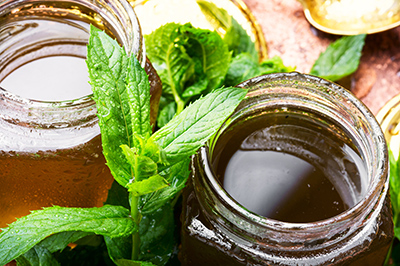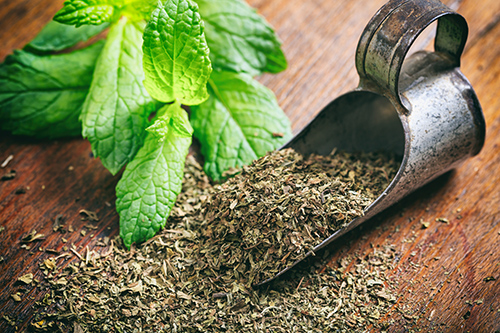There are many benefits of spearmint. The Mentha spicata is a species of spearmint that shares several of the properties of peppermint. The herb is customarily given for women’s problems and painful or suppressed urination. However, an infusion of spearmint combined with horehound is sometimes given to children to treat fevers.
Another species of spearmint, Menta viridus, is nontoxic and like peppermint in its uses. This herb mainly treats slight spasms, gas, indigestion, cramps, flu, and colds. Like the previous species above, it can also be combined with horehound to break fevers in children. It helps stop vomiting and is excellent for restlessness when used as an enema.
Benefits of Spearmint

Spearmint is a fantastic remedy for pneumonia and pleurisy, especially when combined with skullcap and pleurisy root.
NOTE: Avoid boiling the herb because the volatile oil will be steamed off. It can be used with bitter herb combinations to incorporate flavor.

The other mint herbs include catnip (Nepeta cataria) and peppermint (Mentha piperita). Spearmint oil and spearmint have gas-relieving properties and are used worldwide to disguise the flavor of other medicines. This herb has traditionally been antispasmodic, antiseptic, and stomachic.
Spearmint tea’s health benefits include treating fevers, cramps, headaches, colds, stomachaches, diarrhea, and nausea, and it is also a folk remedy for cancer.
WARNING: Spearmint essential oil is toxic if taken internally and can cause dermatitis.

Spearmint Scientific Facts
1. Scientific name—Mentha viridis.
2. Parts of the plant used medicinally—Leaves.
3. Health Properties—Aromatic, diaphoretic, antispasmodic, diuretic, and carminative.
4. What it affects—Circulation, muscles, intestines, and stomach.
How to use Spearmint
- Infusion—Steep for five to fifteen minutes and take six ounces three to four times daily.
- Tincture—Take ½ to one teaspoon three to four times daily.
- Fluid Extract—Take ¼ to ½ teaspoons three to four times daily.
- Powder—Take five to ten #0 capsules (30 to 60 grains) three to four times daily.
DISCLAIMER: All content on this website is presented solely for educational and informational objectives. Do not rely on the information provided as a replacement for advice, diagnosis, or treatment from a qualified medical expert. If you are pregnant, nursing, or have any preexisting medical concerns, talk to your doctor before using any herbal or natural medicines.
REFERENCES
- Vance Ferrell Harold M. Cherne, M.D. The Natural Remedies Encyclopedia [Book]. – Altamont, TN: Harvestime Books, 2010. – Vol. Seventh Edition: 7: pp. 180, 181.
- Grant, P. (2010). Spearmint herbal tea has significant anti-androgen effects in polycystic ovarian syndrome: a randomized controlled trial. Phytotherapy Research, 24(2), 186-188. https://pubmed.ncbi.nlm.nih.gov/19585478
- Mohammadzadeh, F., Ebrahimzadeh Attari, V., & Salehi, I. (2014). Effects of Mentha spicata essential oil on lipid peroxidation and antioxidant enzyme activities in streptozotocin-induced diabetic rats. International Journal of Food Sciences and Nutrition, 65(2), 237-243. https://pubmed.ncbi.nlm.nih.gov/24099429
- Cappello, G., Spezzaferro, M., Grossi, L., Manzoli, L., & Marzio, L. (2007). Peppermint oil (Mintoil) in the treatment of irritable bowel syndrome: a prospective double blind placebo-controlled randomized trial. Digestive and Liver Disease, 39(6), 530-536. https://pubmed.ncbi.nlm.nih.gov/17418661
- Loizzo, M. R., Tundis, R., Menichini, F., Saab, A. M., & Statti, G. A. (2012). Evaluation of Mentha spicata essential oil as an anxiolytic agent: a comparative study with diazepam. Physiology & Behavior, 107(2), 243-251. https://pubmed.ncbi.nlm.nih.gov/22561862 [benefits of spearmint]
- Moss, M., Oliver, L., & Hewitt, J. (2016). Modulation of cognitive performance and mood by aromas of peppermint and ylang-ylang. International Journal of Neuroscience, 126(1), 50-59. https://pubmed.ncbi.nlm.nih.gov/25761073
